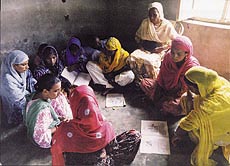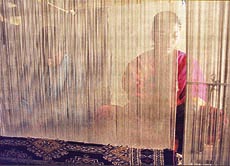Upgrading their quality of life
By
Sanjeev Singh Bariana
- A farm labourer till
two year ago,
 Sukhjinder Singh was often jobless
for months together. Today he runs an electricity
gadgets repair shop in Kot Kapura, earning more
than Rs 3,000 per month. Sukhjinder Singh was often jobless
for months together. Today he runs an electricity
gadgets repair shop in Kot Kapura, earning more
than Rs 3,000 per month.
- Twentytwo-year-old
Kiranjot did not dream beyond getting married and
raising a family after her plus two. Today she
supervises adult education and vocational
training centres in six villages of her block in
Kot Kapura. Even 50-year-olds respectfully
address her as behanji.
- Jaswant Kaur (50)
spent her entire life making cakes of cow dung.
Today, she weaves carpets on a handloom and also
trains girls of her locality.
THESE are only a few instances of
the social and economic uplift of the less privileged
lot. The Bharat Gyan Vigyan Samithi (BGVS) is the spirit
behind the transformation of the quality of life in 84
villages of Kot Kapura in Faridkot district of Punjab.
Making big announcements
about crores and lakhs of rupees for a totally literate
society is one thing. To walk patiently over human,
administrative and social hurdles to achieve the goal is
another story altogether. During times when the
bureaucratic and political deadlines for complete
literacy have lost their meaning, this movement in Kot
Kapura made an impact on the social and educational
fabric of the area in less than seven years.
The impact is clearly
visible in at least half of the population of 84 villages
covered under the project. "Although the BGVS
undertakes literacy-oriented courses all over the state,
this area is under a special project. In the first phase,
57,000 illiterates were identified. As many as 26,000
joined the literacy classes. As many as 10,000 left
mid-way", says Dr Pyara Lal Garg, project
coordinator for Punjab and Chandigarh.
The post-literacy campaign
was a bigger success. A total of 34,980 attended the
classes. Of these 10,497 reached the fourth stage, while
10,502 reached the second stage. The dropout rate was
negligible, the samithi figures indicate.
"Convincing the villagers was the biggest
problem", says Shakuntala Devi, block coordinator.
‘What is the need to study at the age of 70?’
one Dhapar Devi had said. Today she can read the Ramayana
and other scriptures’, Shakuntala Devi added.
"Each project has its
own strategy. The execution of any development programme
in any one part of the country cannot be a duplicate of
the other due to social, economic and regional factors of
the community involved", a sub-block coordinator
said.
Even in Kot Kapura the
strategy was evolved "naturally". Lok Chetna
Sabhas were constituted in every village in addition to
Naari Chetna Sabhas. The sabhas combined to form kendras
representing a group of villages. All kendras
collectively chose members of the block committee, giving
people a chance in decision-making. This has encouraged
mass participation. The block committee meets on the 12th
of every month where each village submits its monthly
progress report.
Members earlier got
travelling allowance for the monthly meetings. But the
paucity of funds has being faced now not deter people
from coming in large numbers for the monthly meeting, as
was evident when the Tribune team visited Kot Kapura
recently.
Volunteers include school
teachers and several other educated people who want to
contribute towards the growth of society. Cultural
artistes like Jaswinder Singh "Kakka" write and
present plays and skits, spreading the message of
literacy.
In the process of
imparting reading and writing skills, the team felt the
need for additional motivation to keep people involved as
well as to make them self-sufficient.
Training centres for
sewing, knitting, carpet-weaving, typing and electronics
were set up. The centres are totally self-financed. The
fee structure is decided by the Lok Chetna Sabha of the
village or the locality keeping in mind the paying
capacity of the student.
Embroidery training
centres have been opened at Bhana, Sirsadi, Harima and
Nanaksar villages; sewing and stitching centres at
Sandhwan, Jaito, Surghuri and Kot Kapura; chair weaving
schools at Behbal Kalan, Jeewanwala, Behbal Khurd and
Jaito; and typing centres at Khara, Jeewanwala and
Nangal. A number of libraries have also been opened in
several villages with a nominal membership fee.
Shakuntala Devi pointed
out various administrative hurdles. "The local
administration has asked us to close down our office in
Kot Kapura. Officials seem annoyed with the BGVS for
pointing out the failure of the administration-sponsored
literacy mission," she said. She also showed
clippings of vernacular dailies, pointing alleged
irregularities in the functioning of the Zila Saksharta
Samithi.
Dr Garg, state
coordinator, says, "Two districts of Hoshiarpur and
Faridkot were taken up for total literacy campaigns by
the district administrations in collaboration with the
BGVS. The samithi has provided the training material. It
has also imparted training to resources persons for
teaching in two districts".
"Three more
districts, namely Rupnagar, Sangrur and Ludhiana, have
also come forward for total literacy. The samithi has
also undertaken other issues like gender equity, national
integration, self reliance and universalisation of
elementary education," he says.
"Bringing in
10,000-odd children under the primary education network
in Kot Kapura is on top of the agenda", Dr Garg adds

|

